Baked chilli & jacket potatoes
Ingredients
- 4 large jacket potatoes
- 1 tbsp sunflower oil
- 2 red onions, chopped
- 3 garlic cloves, crushed
- 1 sachet (30-39g), chilli con carne seasoning mix
- 500g beefmince
- 100g smoked bacon lardons
- 2 tbsp tomato purée
- 400g can chopped tomatoes
- 400g can black beans, drained
- soured cream, grated cheese and coriander leaves, to serve
- Heat oven to 200C/180C fan/gas 6. Prick the potatoes all over with a fork, then put on a baking sheet and bake in the oven for 1 hr.
- While the potatoes are baking, heat the oil in a large frying pan. Add the onion and fry over a high heat for 5 mins until softened. Add the garlic and chilli sachet. Stir a few times to coat the onions in the spices, then tip the onion mixture into a large ovenproof dish.
- Put the pan back over high heat and add the beef mince, breaking it up with a spatula as you go. Cook until starting to become crisp at the edges, then add to the dish with the onions. Return the pan to heat and cook the bacon until crisp at the edges. Add the bacon to the beef and stir to combine.
- Stir in the tomato purée and tomatoes, then put the dish in the oven with the potatoes and bake for 25-30 mins until bubbling and starting to thicken. Stir in the beans and season well. Return to the oven for 5 mins to warm through.
- Cut a cross in the top of each potato and squeeze the sides to open. Spoon in the baked chilli and top with soured cream, cheese and coriander if you like.
Coated Peanuts a.k.a. Peanut Burger

 Coated Peanuts also known in Nigeria as Peanut Burger is popular
amongst those who have tasted the tinned version of this snack. Here is
how to make yours at home.
Coated Peanuts also known in Nigeria as Peanut Burger is popular
amongst those who have tasted the tinned version of this snack. Here is
how to make yours at home.Ingredients
For Coated Peanuts (Peanut Burger) that taste as close to the Koh Kae® brand of coated peanuts, you will need the following ingredients.- 1 cup roasted peanuts/groundnuts
- ⅓ cup plain flour (all-purpose flour)
- ⅓ cup corn flour
- ⅓ cup rice flour
- ¼ cup icing sugar
- ½ teaspoon baking powder
- ½ teaspoon baking soda
- 1 egg
- ¼ teaspoon salt
- ½ teaspoon ground dry cayenne pepper
- ½ teaspoon cinnamon
- Vegetable oil (for frying)
Notes about the ingredients
- Use roasted peanuts that are still stuck together. Do not use broken ones.
- I love my coated peanuts spicy that's why I added dry cayenne pepper, if you do not want yours spicy, leave it out.
- You can buy cinnamon from big supermarkets or bakery shops in Nigeria. If you cannot find it, use nutmeg but cinnamon is tastier.
- You can also make coconut flavour of this snack.
Directions
- Mix all the dry ingredients together. Sift with a sieve.
- Whisk the egg very well until foamy.
- Add 1 heaped tablespoon of the mixed dry ingredients to the egg and whisk again till you have a smooth light batter. See the video below.
- Put the roated peanuts/groundnuts in another bowl, scopp a small quantity of the egg batter into the peanuts. Shake the contents in a circular motion. Watch the video below.
- Add the dry ingredients mixture, shake in a circular motion till the peanuts are coated with the dry ingredients.
- Keep adding these two ingredients alternately till all ingredients have been used up.
- Deep fry in the oil.
- It is best to watch the video below for a visual understanding of the recipe.
Enjoy coated peanuts with a chilled drink.
How to cook Rivers Native Soup

Rivers Native Soup is a gift from the people of Rivers State in the Niger Delta Area of Nigeria. These are the riverine people that use the freshest seafood to prepare expensive soups and meals.
But you do not have to break a bank to prepare this soup if you are not a fisherman. You can cut down on some of the ingredients but whatever you do, make sure you add clams because it adds a lot of flavour to this soup.
Ingredients for Rivers Native Soup
The following quantities of ingredients are what I used to prepare a decent pot of Rivers Native Soup:
- 3 medium fresh fish
- 9 snails
- 2 cups clams
- 1 cup sea snails
- ½ cup periwinkles
- 1 cup shrimps
- 6 medium cocoyams
- 1 tablespoon uziza seeds (false cubeb)
- 1-2 yellow habanero peppers
- 2 big stock cubes
- Bitter leaves (washed)
- 5 Uziza leaves (false kubeb)
- 2 cooking spoons (¼ cup) red palm oil
Notes on the recipe and ingredients
- According to the lady who gave me the list of ingredients for this native soup, you should use only fresh seafood when preparing Rivers Native Soup. That means such ingredients like crayfish and dry fish which are dry seafood are not allowed.
- You can use achi or ofor as alternative to cocoyam. But achi has a distinctive taste that can ruin this recipe for some people. It ruins it for me.
- Habanero pepper atarodo, ose oyibo or atarugu. You can also use scotch bonnet peppers. For this recipe, I used the yellow habanero peppers.
- You can also add oysters to native soup.
- I used gilt-head sea bream fish. Fresh catfish should be your first choice of fresh fish is you can buy it where you live.
Before you cook Rivers Native Soup
- Shell the clams, snails, sea snails and periwinkles and remove the intestines. In Nigerian markets, the sellers can do these for you. Watch the video below to see how I remove the shells from these seafood. For the snails, you need to remove the slime after removing the shell to see how to remove the slime from snails.
- Cook the cocoyam till soft. Peel and pound till smooth with a mortar and pestle. You can also blend with a power blender or food processor.
- Grind/pound the yellow pepper.
- Grind the uziza seeds with a spice grinder.
- Slice the uziza leaves.
- Cut up the fish and clean.
Cooking Directions
- Place the snails in a pot, add the seasoning cubes, pour water to cover and cook for 20 minutes.
- Add ground uziza, the clams, sea snails, shrimps and fish, top up the water if necessary and cook till the fish is done.
- Take out the fish from the pot and set aside.
- Add the cocoyam in small lumps. Add the bitter leaves, yellow pepper and palm oil. Cover and cook till the lumps of cocoyam dissolve. Stir the contents of the pot very often.
- Add salt to taste.
- Add the fish back into the pot of soup. Stir, cover and let it simmer.
- That's it!
COCONUT RICE AS E DEY HOT! COOKED WITH CARROTS, PEPPERS AND MORE

Coconut rice cooked with carrots and peppers.
This coconut rice cooked with different peppers and carrot is not like any you have tasted before. It's different, nutritious and delicious. This will keep you away from the Doctor. There are other coconut rice recipes on the blog, you'll love them and this too. Variety they say is the spice of life.
INGREDIENTS:
4 cups rice
1 and 1/2kg chicken
1 large onion
salt to taste
2 seasoning cubes, you can use 2 more to stir fry the vegetables
2 sachets coconut milk powder OR you use 2 large coconuts
1/4 teaspoon oregano (Optional)
1/4 teaspoon curry
1/4 teaspoon thyme
1 small green pepper
1 small tatashey
3 scotch bonnet peppers (Ata rodo)
2 medium sized tomato fruits
1 small yellow pepper
3 medium sized carrots
1 cup vegetable oil to stir fry vegetables. I used soya oil here
Water of course
DIRECTION
Boil the chicken briefly with onion and salt to get stock, grill, bake or fry the chicken and set aside. I
grilled this one in a fry pan sha.
Wash and cook rice in the chicken stock. Mix the coconut powder into a smooth paste and add to the stock with seasoning cubes if needed oh, check for salt. While rice cooks, wash and dice the vegetables and fruits, stir fry with thyme, curry, oregano, onion,seasoning cubes and set aside.
When rice begins to cook, almost done oh, add the stir fried vegetables and mix, Check for salt, reduce the heat again and leave to simmer until completely cooked. Serve hot!
Happy weekend!
NB: If you are cooking with 2 large coconuts, remove the shell, cut coconut in tiny pieces, add water and blend or grate with a manual grater. Then, add warm water about 3 to 4 cups, squeeze a bit and sieve with a cheesecloth (The ones used to filter ogi/akamu/pap. Add the milk to your stock and continue cooking. Use the chaff for other meals like coconut fufu etc
See Step by step cooking pictures below...

Vegetables being stir fried

Adding the stir fried vegetables to almost cooked rice

Coconut rice with carrots, peppers

 |
| Coconut rice cooked with carrots and peppers. |
INGREDIENTS:
4 cups rice
1 and 1/2kg chicken
1 large onion
salt to taste
2 seasoning cubes, you can use 2 more to stir fry the vegetables
2 sachets coconut milk powder OR you use 2 large coconuts
1/4 teaspoon oregano (Optional)
1/4 teaspoon curry
1/4 teaspoon thyme
1 small green pepper
1 small tatashey
3 scotch bonnet peppers (Ata rodo)
2 medium sized tomato fruits
1 small yellow pepper
3 medium sized carrots
1 cup vegetable oil to stir fry vegetables. I used soya oil here
Water of course
4 cups rice
1 and 1/2kg chicken
1 large onion
salt to taste
2 seasoning cubes, you can use 2 more to stir fry the vegetables
2 sachets coconut milk powder OR you use 2 large coconuts
1/4 teaspoon oregano (Optional)
1/4 teaspoon curry
1/4 teaspoon thyme
1 small green pepper
1 small tatashey
3 scotch bonnet peppers (Ata rodo)
2 medium sized tomato fruits
1 small yellow pepper
3 medium sized carrots
1 cup vegetable oil to stir fry vegetables. I used soya oil here
Water of course
DIRECTION
Boil the chicken briefly with onion and salt to get stock, grill, bake or fry the chicken and set aside. I
grilled this one in a fry pan sha.Boil the chicken briefly with onion and salt to get stock, grill, bake or fry the chicken and set aside. I
Wash and cook rice in the chicken stock. Mix the coconut powder into a smooth paste and add to the stock with seasoning cubes if needed oh, check for salt. While rice cooks, wash and dice the vegetables and fruits, stir fry with thyme, curry, oregano, onion,seasoning cubes and set aside.
When rice begins to cook, almost done oh, add the stir fried vegetables and mix, Check for salt, reduce the heat again and leave to simmer until completely cooked. Serve hot!
Happy weekend!
NB: If you are cooking with 2 large coconuts, remove the shell, cut coconut in tiny pieces, add water and blend or grate with a manual grater. Then, add warm water about 3 to 4 cups, squeeze a bit and sieve with a cheesecloth (The ones used to filter ogi/akamu/pap. Add the milk to your stock and continue cooking. Use the chaff for other meals like coconut fufu etc
See Step by step cooking pictures below...
 |
| Vegetables being stir fried |
 |
| Adding the stir fried vegetables to almost cooked rice |
 |
| Coconut rice with carrots, peppers |
 |
Mashed Peas and Potatoes with Corn (Irio)
Senegalese Lemon Chicken
How to cook Ofe Akwu (Banga Stew)

 Ofe Akwu (Banga Stew) can be prepared with fresh palm fruits or tinned palm fruit concentrate. On this page, I will give details of how to prepare delicious Ofe Akwu with tinned palm fruit concentrate (tinned banga). This stew is used to eat Boiled White Rice. You can also use the tinned palm fruit concentrate for Delta Banga Soup.
Using tinned banga for Ofe Akwu saves you lots of time and energy you would have used to extract the palm fruit concentrate and it is perfect for those who live outside Nigeria where palm fruits are not easily available. The good thing is that it tastes the same as when fresh palm fruits are used, that is if you buy a good brand: watch the video below for more information.
The recipe on this page is the same for Delta Banga Soup that is served with Starch, just replace the scent leaves with dried and crushed bitter leaves and add the other traditional spices for Banga Soup.
Ofe Akwu (Banga Stew) can be prepared with fresh palm fruits or tinned palm fruit concentrate. On this page, I will give details of how to prepare delicious Ofe Akwu with tinned palm fruit concentrate (tinned banga). This stew is used to eat Boiled White Rice. You can also use the tinned palm fruit concentrate for Delta Banga Soup.
Using tinned banga for Ofe Akwu saves you lots of time and energy you would have used to extract the palm fruit concentrate and it is perfect for those who live outside Nigeria where palm fruits are not easily available. The good thing is that it tastes the same as when fresh palm fruits are used, that is if you buy a good brand: watch the video below for more information.
The recipe on this page is the same for Delta Banga Soup that is served with Starch, just replace the scent leaves with dried and crushed bitter leaves and add the other traditional spices for Banga Soup.
Ingredients for Ofe Akwu
- 800g tinned Palm Fruit Concentrate
- 1kg Beef (cut into medium pieces)
- 3 pieces mangala (dry fish)
- Scent leaves
- 1 red onion
- 1 handful crayfish
- Habanero pepper (to taste)
- Salt (to taste)
- 1 small piece ogiri okpei (iru, dawa dawa)
- 3 small stock cubes
Note on the ingredients for Ofe Akwu (Banga Stew)
- You can use any of the following meat: goat meat, beef or lamb for Ofe Akwu. It is not advisable to use chicken for Ofe Akwu because this stew is too traditional for chicken.
- You can use dried cat fish, mangala or smoked fish.
- You can add stockfish.
- Though I mentioned the quantities of meat and fish, add the quantities of these two ingredients as you wish.
- I recommend red onion for Ofe Akwu because it brings out the taste of this stew.
- The scent leaves give the Ofe Akwu its unique aroma and taste. If you are outside Nigeria, scent leaf (nchanwu, efinrin) has no alternative. I buy scent leaves direct from Nigeria. When they arrive, I rinse and slice them and store in my freezer as I stated in the video below. Some people use mint leaves as alternative but it is a no from me. I would rather use parsley.
Before you cook Ofe Akwu (Banga Stew)
- In the video below, I grilled/smoked the pieces of beef I used in cooking the Ofe Akwu. This takes the Ofe Akwu to a whole new level of deliciousness. So if you want to do like me, crush two of the stock cubes into the pieces of beef, massage into the beef and grill in the oven till tender but not dry (see the video below). If you do not want to use grilled beef, skip this step.
- Soak the dry fish till soft then debone and break into pieces. If using smoked fish, rinse, debone and break into pieces.
- Open the tinned palm fruit concentrate, stir to mix and set aside.
- Wash and cut the scent leaves into tiny pieces.
- Chop the onion.
- Grind or pound the crayfish with the ogiri okpei.
- Grind or pound the habanero pepper.
Cooking Directions
- If you are using grilled beef, place the grilled pieces in a pot, add the deboned dry fish, diced onions and the remaining one stock cube. Pour water to just about the same level of the contents (about 2 small cups of water) and start cooking.
- If you are not using grilled beef, place the beef in a pot, add the diced onion and crushed stock cubes. Steam till water starts seeping out of the beef and continue cooking till the beef is tender. Add water when necessary as you cook. It is important that you have as little water as possible in the pot when the meat is done.
- If using step 1, cook till it boils and leave it to boil for 5 minutes. If using step 2, when the beef is done, add the deboned dry fish and cook for 5 minutes. In both cases, if using smoked fish, do not add it now, you will add it later.
- Add the habanero pepper, ground crayfish and ogiri okpei.
- Stir very well and add the palm fruit concentrate (tinned banga) in scoops. Stir and add more water if necessary to bring the stew to the consistency you like for your stews. It is advisable to have some hot water ready for this.
- Add the smoked fish (if you are using it), cover and let it boil on medium heat till you see some red oil float to the surface.
- Add the scent leaves and salt stir and cook till it boils again and it is done.
How to Cook Garden Egg Sauce/Stew
 Garden Egg Sauce may well be the best sauce for Boiled White Yam. It contains palm oil which boiled yam loves. It can also be prepared with vegetable oil but I do not recommend that. Keep reading for details.
Garden Egg Sauce is the perfect match for:
Garden Egg Sauce may well be the best sauce for Boiled White Yam. It contains palm oil which boiled yam loves. It can also be prepared with vegetable oil but I do not recommend that. Keep reading for details.
Garden Egg Sauce is the perfect match for:
- Boiled White Puna Yam (best combo)
- Boiled Plantains
- Agidi/Eko
- Boiled White Rice (when cooked with vegetable oil)
- Boiled Potatoes (when cooked with vegetable oil)
Ingredients for Garden Egg Sauce
- 8 big garden eggs
- 1 cup palm oil
- 1 onion
- Habanero Pepper & Salt (to taste)
- 1 small ogiri okpei (iru)
- 2 small smoked mackerels
Important notes on the ingredients + alternatives
- Always buy baby garden eggs. These are garden eggs that are harvested as soon as they mature. If they over-mature or are even beginning to ripe, the seeds will be very tough and hard for the blender to grind. Even worse if you are using a mortar and pestle.
- I prefer the white or off-white variety of garden eggs for this recipe. You can also use the green variety.
- You can use eggplant or aubergine as alternative for garden eggs. In that case, use about 3 for the stated quantities of ingredients.
- Fry with palm oil if you will use the garden egg sauce for boiled white yam or boiled plantains. Fry with a tasteless and odourless vegetable oil if you will use it to eat boiled white rice or boiled potatoes. In my opinion, this sauce should only be prepared with palm oil because it is more delicious. Palm oil gives the sauce a unique delicious flavour.
- The palm oil adds colour to this sauce. This means that when you fry with vegetable oil, it does not look as appetizing.
- Ogiri okpei (iru) is a traditional seasoning made from locust beans. If you do not have it, use stock cubes. Also, when preparing this recipe with vegetable oil, use stock cubes.
- You should add enough palm oil to fry the garden egg puree. Palm oil is good for you! If you are in Nigeria use a milk cup to measure the palm oil.
- You can use boiled mackerel if you do not have smoked mackerel but smoked is the way to go.
Kitchen tools and equipment
Before you cook Garden Egg Sauce
- Rinse the garden eggs very well and remove the stalk.
- Blend the garden eggs. There are 3 ways to turn the garden eggs into a smooth puree:
- With a blender:
- Cut the garden eggs into small pieces.
- Put in a blender and pour just enough water to help the blades of your blender move.
- Blend till smooth.
- With a mortar and pestle:
- Boil some water in a pot.
- Add the garden eggs and continue to cook till the are soft.
- Peel the water-proof skin of the garden eggs.
- Pound in a mortar till a smooth puree is achieved.
- With a sieve:
- Cut the garden eggs into small pieces.
- Put the garden egg pieces in a pot and pour some water to the same level as the contents of the pot.
- Cook till the pieces are very soft, soft enough to melt when you press with a fork.
- Keep cooking till almost all the water has dried.
- Pour into a sieve with a wire mesh or any other rough sieve and mash it up.
- With a blender:
- Cut the onion into small pieces.
- Pound the pepper and ogiri okpei in a mortar till smooth.
- Prepare the smoked fish if you don't have some and separate them into small pieces.
- Start cooking the yam or the staple food you will serve with the garden egg sauce.
Cooking Directions
- Pour the garden egg puree into a clean pot and cook till all or almost all the water dries up. Set it aside. Skip this step if you prepared the garden egg puree using step b above.
- Pour the palm oil into a clean dry pot and heat it up. Do not bleach it, you only need to heat till a piece of onion sizzles when added to the hot oil.
- When the oil is hot enough, add the onions and fry for about 2 minutes.
- Add the garden egg puree and stir for a bit. Cover the pot and cook-fry for some time and stir again.
- Repeat step 4 till the small amount of water in the puree dried up. the paol oil will also be separated from the puree.
- Add the ogiri okpei and habanero pepper blend then add salt to your taste.
- Add the smoked fish, stir, cover and leave to simmer and it's done!
Use the Garden Egg Sauce to eat Boiled White Puna Yam (best combo), Boiled Plantains and Agidi/Eko. If you fried the sauce with vegetable oil, use for Boiled White Rice and Boiled Potatoes.
Vegetable & Shrimp Sauce
Before you cook the Vegetable Sauce
I am assuming that you have thoroughly washed all the ingredients that need to be washed.
- Peel the shrimps if they are not already peeled.
- Dice the onions, the sweet peppers (deseeded) and the habanero peppers.
- Slice the ugu leaves.
- Start preparing the staple that you will serve it with. I am using yam so i cut and peel the yam, rinse, put in a pot and add water to cover it.
Cooking Directions
- Start cooking the yam.
- On another burner, set the frying pan or pot and pour the vegetable oil.
- When hot, add some of the diced onions.
- Add the shrinps and sautee for 7 minutes, stirring it all the time.
- When slightly brown, remobe the shrimps from the frying pan and set aside.
- Add the remaining onions into the oil in the frying pan and fry for about 3 minutes or till slightly brown.
- Add the diced peppers and fry for 5 minutes.
- Crush and add the stock cubes, salt and the black pepper.
- Stir and add the sliced ugu and stir very well.
- Add the fried shrimps, stor and it is done!
Serve with the boiled white yam. Yum!
 This Vegetable and Shrimp Sauce is perfect for Boiled White Yam, Rice, Potatoes, Plantain and other boilable staple food.
And very easy to prepare.
This Vegetable and Shrimp Sauce is perfect for Boiled White Yam, Rice, Potatoes, Plantain and other boilable staple food.
And very easy to prepare.
Ingredients
- 10 shrimps
- 1 medium bowl ugu leaves
- 2 cooking spoons vegetable oil
- 2 sweet peppers (paprika)
- 2 habanero peppers or to taste
- 1 onion
- 1 teaspoon black pepper (optional)
- 2 small stock cubes
- Salt (to taste)
Staple
You will also need the staple food that you will serve with the Vegetable and Shrinp Sauce. I will be using yam (white puna yam).
- Yam or
- Rice or
- Potatoes or
- Plantains
Peppered Snails
 Peppered Snails are a common feature in Nigerian restaurants' menus. They are also served as Small Chops at parties.
With Peppered Snails, you need to mind the pepper!
It is so easy to prepare Peppered Snails. All the hard work goes to cleaning the snails, once you are done with that, the rest of the preparation is very easy.
Peppered Snails are a common feature in Nigerian restaurants' menus. They are also served as Small Chops at parties.
With Peppered Snails, you need to mind the pepper!
It is so easy to prepare Peppered Snails. All the hard work goes to cleaning the snails, once you are done with that, the rest of the preparation is very easy.
Ingredients for Peppered Snails
I used:
- 10 medium snails
- 4 habanero peppers (or to your taste)
- 5 plum tomatoes
- 1 onion
- 1 big stock cube
- 1 cooking spoon vegetable oil
- Salt (to taste)
For serving:
- 1 onion
Tool you'll need: toothpicks for serving.
Notes on the ingredients
- Be careful about the quantity of seasoning you add to snails. They can easily get over-seasoned and taste salty because due to the texture of the meat, it does not absorb much of the seasoning.
- You can skip the tomatoes and use only habanero peppers. But you will need lots of peppers to make enough stew for the snails, that means the Peppered Snails will be too spicy hot and all you can taste is the pepper. Not good.
Before you make Peppered Snails
- Break the shells of the snails and clean the snail slime.
- Cut half of the first onion into big chunks. Cut the other half into tiny pieces.
- Cut the habanero peppers (scotch bonnet) into tiny pieces.
- Remove the seeds from the tomatoes and cut them into thin slices.
Making the Peppered Snails
- Put the cleaned snails in a pot and pour water to cover them.
- Add the stock cube and the chunks of onion. I use chunks of onion when I want to season with onions without having pieces of onions in what I am cooking.
- Cover and start cooking on medium heat. While cooking, top up the water when necessary so it does not burn.
- Put the sliced tomatoes, pepper and onions in another pot and start cooking on medium heat. The aim is to steam them till they are soft. Stir from time to time so it does not burn.
- After 30 minutes, the snails should be well cooked. Remember to top up the water as you cook them. Note that the tongue of the snails are still crunchy even when the snails are done.
- Remove the chunks of onion from the snails. Increase the heat to high and stir constantly till all the remaining liquid in the pot is absorbed. You don't want to lose any flavour by pouring away the snail stock. Set it aside.
- When the water dries from the pepper, tomatoes and onions, add the vegetable oil and fry for about 5 minutes. Stir continuously so it does not stick to the pot.
- Add salt and stir very well.
- Add the cooked snail. Stir very well and add more salt if necessary.
- That's it! Leave to cool down a bit, insert toothpicks and serve with onions.
If you are entertaining guests or having dinner with the family, serve it as a side dish to Fried Plantains or Jollof Rice. You can also serve them with a chilled drink.
For parties, serve as Small Chops.
Cowfoot Porridge
 Cowfoot Porridge can also be Cowfoot & Yam Pepper Soup if you add enough water to it. I prefer mine a bit watery but my kids love a thick porridge because that way, they have more control over the surrounding liquid.
Prepare and serve this on a cold rainy day and you will be glad you did!
Cowfoot Porridge can also be Cowfoot & Yam Pepper Soup if you add enough water to it. I prefer mine a bit watery but my kids love a thick porridge because that way, they have more control over the surrounding liquid.
Prepare and serve this on a cold rainy day and you will be glad you did!
Ingredients for Cowfoot Porridge
- 720g (1.5 lbs) cow foot
- 12 medium cubes white puna yam
- 1 teaspoon ground Ehu (Calabash Nutmeg)
- 1 teaspoon black pepper
- Habanero pepper (to your taste)
- 1 big onion
- 2 big stock cubes
- Salt (to taste)
- 5 Scent leaves
Notes on the ingredients
- 720g of cow foot may sound like a lot but cow foot is mostly bones.
- Cow foot is quite tough so if you have a pressure cooker, use it for cooking it to save time and gas/electricity. I cook mine for 15 minutes (counting from when the pot is pressurized).
- Ehu (Calabash Nutmeg) is a very traditional ingredient that is difficult to find outide Nigeria. If you can't buy it where you live, skip it. Ordinary nutmeg is not an alternative to this because they are not similar in any way. If you have friends or family in Nigeria, they will be able to buy ehu seeds and send to you, a small quantity goes a long way.
- Scent leaves give this meal a nice taste. A great alternative for me is parsley. Some people say that mint leaves make a great alternative to scent leaves. But it's a no for me.
Notes on the ingredients
- 720g of cow foot may sound like a lot but cow foot is mostly bones.
- Cow foot is quite tough so if you have a pressure cooker, use it for cooking it to save time and gas/electricity. I cook mine for 15 minutes (counting from when the pot is pressurized).
- Ehu (Calabash Nutmeg) is a very traditional ingredient that is difficult to find outide Nigeria. If you can't buy it where you live, skip it. Ordinary nutmeg is not an alternative to this because they are not similar in any way. If you have friends or family in Nigeria, they will be able to buy ehu seeds and send to you, a small quantity goes a long way.
- Scent leaves give this meal a nice taste. A great alternative for me is parsley. Some people say that mint leaves make a great alternative to scent leaves. But it's a no for me.
Before you make the Cowfoot Porridge
- Cut the cow foot into medium chunks. Where I live, the butchers cut it for me.
- Peel the yam and cut into medium cubes.
- Pound/grind the habanero pepper.
- Grind the ehu.
- Cut the onion into 2 to 4 big chunks.
- If using scent leaves, use your finger tips to tear the leaves into medium pieces. No need to cut parsley.
Directions
- Rinse and put the cow foot chunks in a pot.
- Add enough water to cover the meat. If you want the porridge as thick as that of Yam Porridge, add less water.
- Add chunks of onion. I use chunks of onion when I don't want pieces of onion in what I'm cooking.
- Add the stock cubes (crushed), black pepper, ground ehu (calabash nutmeg) and habanero pepper.
- Cover the pot and cook the cowfoot till done to your liking. If using a pressure pot, when done, depressurize under running water and set the pot back on the stove.
- Add the yams and some salt. Cover and cook till the yams are well done. If using a pressure pot, there's no need to pressurize it this time.
- When the yams are cooked to your liking, remove the big chunks of onion and add the vegetables.
- Stir and it's ready to be served.
Serve piping hot with a chilled drink: palm wine, beer or stout and soft drinks.
How to cook Nigerian Dan Wake


Dan Wake which literally means Son of Beans is a Northern Nigerian recipe. You can call Dan Wake Beans Dumplings in English because the preparation is similar.
Dan Wake on its own is pretty tasteless just like fufu meals and it relies on a sauce or side dish for its taste just like our fufu meals rely on Nigerian Soups for their tastes.
Usually Dan Wake is served with ground cayenne pepper (yaji), you can also use Suya Pepper, hardboiled eggs, sautéed vegetables: onions, cabbage, tomatoes; and you can even see some people crush stock cubes and sprinkle on top. Whatever floats your boat, the Dan Wake is game.
For me, I searched far and wide for a tasty sauce to enjoy Dan Wake with and one day I found it: 9jafoodie's Ultimate Nigerian Stir-fry is the ultimate partner for Dan Wake. It contains lots of vegetables, Suya pepper, different Nigerian meats etc. Go check it out!


Dan Wake which literally means Son of Beans is a Northern Nigerian recipe. You can call Dan Wake Beans Dumplings in English because the preparation is similar.
Dan Wake on its own is pretty tasteless just like fufu meals and it relies on a sauce or side dish for its taste just like our fufu meals rely on Nigerian Soups for their tastes.
Usually Dan Wake is served with ground cayenne pepper (yaji), you can also use Suya Pepper, hardboiled eggs, sautéed vegetables: onions, cabbage, tomatoes; and you can even see some people crush stock cubes and sprinkle on top. Whatever floats your boat, the Dan Wake is game.
For me, I searched far and wide for a tasty sauce to enjoy Dan Wake with and one day I found it: 9jafoodie's Ultimate Nigerian Stir-fry is the ultimate partner for Dan Wake. It contains lots of vegetables, Suya pepper, different Nigerian meats etc. Go check it out!
Ingredients
The Dan Wake made with the following quantities of ingredients were enjoyed by 3 people.
- 2 small party cups beans flour
- 1 small party cup cassava flour
- 2 teaspoons baking soda or 2 teaspoons edible potash
- 2 tablespoons kuka powder
- Beef stock
The Dan Wake made with the following quantities of ingredients were enjoyed by 3 people.
- 2 small party cups beans flour
- 1 small party cup cassava flour
- 2 teaspoons baking soda or 2 teaspoons edible potash
- 2 tablespoons kuka powder
- Beef stock
Serve Dan Wake with any or all of the following:
- Ultimate Nigerian Stir-fry
- Ground cayenne pepper (yaji)
- Suya Pepper (Suya Spice)
- Sautéed vegetables
- Sliced Vegetables
- Onions
- Cabbage
- Tomatoes
- Cucumber
- Stock Cubes
- Hard boiled Eggs
- Ultimate Nigerian Stir-fry
- Ground cayenne pepper (yaji)
- Suya Pepper (Suya Spice)
- Sautéed vegetables
- Sliced Vegetables
- Onions
- Cabbage
- Tomatoes
- Cucumber
- Stock Cubes
- Hard boiled Eggs
Notes on the ingredients
- Whatever quantity of Dan Wake you are making, use 2 parts of beans flour to 1 part of cassava flour so like I did above, I used 2 party cups of beans flour and 1 party cup of cassava flour.
- The job of the cassava flour is to bind the beans flour as it contains lots of starch. If you do not have cassava flour, use plain flour (all-purpose flour).
- Water is normally used to mix the Dan Wake but I prefer using beef stock because it gives it a better taste rather than the bland taste you get when you mix with water. Even though I use a very tasty sauce to eat Dan Wake, the meal tastes better when it is seasoned all the way through.
- The job of the edible potash is to make the Dan Wake balls fluffy. I used baking soda (bicarbonate of soda) in the video below, they do the same job.
- I get the beef stock when I prepare grilled meat. I boil the meat and store the water (stock) in the freezer for preparing these sort of meals. Also, since I normally eat Dan Wake with the Ultimate Nigerian Stir-fry, I will use some of the stock from boiling the meats for the stir-fry to mix the Dan Wake.
- Kuka Powder which is dried and ground baobab leaves is mucilaginous in nature like Ogbono, not as much as Ogbono though and its job is to help bind the Dan Wake even more.
- These days some people prepare Dan Wake with only all-purpose flour but the original traditional ingredient for Dan Wake beans flour, try both and see which you prefer.
- Whatever quantity of Dan Wake you are making, use 2 parts of beans flour to 1 part of cassava flour so like I did above, I used 2 party cups of beans flour and 1 party cup of cassava flour.
- The job of the cassava flour is to bind the beans flour as it contains lots of starch. If you do not have cassava flour, use plain flour (all-purpose flour).
- Water is normally used to mix the Dan Wake but I prefer using beef stock because it gives it a better taste rather than the bland taste you get when you mix with water. Even though I use a very tasty sauce to eat Dan Wake, the meal tastes better when it is seasoned all the way through.
- The job of the edible potash is to make the Dan Wake balls fluffy. I used baking soda (bicarbonate of soda) in the video below, they do the same job.
- I get the beef stock when I prepare grilled meat. I boil the meat and store the water (stock) in the freezer for preparing these sort of meals. Also, since I normally eat Dan Wake with the Ultimate Nigerian Stir-fry, I will use some of the stock from boiling the meats for the stir-fry to mix the Dan Wake.
- Kuka Powder which is dried and ground baobab leaves is mucilaginous in nature like Ogbono, not as much as Ogbono though and its job is to help bind the Dan Wake even more.
- These days some people prepare Dan Wake with only all-purpose flour but the original traditional ingredient for Dan Wake beans flour, try both and see which you prefer.
Before you cook Dan Wake
There's not much pre-preparation going on with Dan Wake. The only thing is that if you are using edible potash, mix it with a small quantity of water and sieve. You will use only the liquid, no sediments. Set this liquid aside.
There's not much pre-preparation going on with Dan Wake. The only thing is that if you are using edible potash, mix it with a small quantity of water and sieve. You will use only the liquid, no sediments. Set this liquid aside.
Cooking Directions
- Mix all the dry ingredients in a bowl: beans flour, cassava flour, baking soda and kuka powder.
- If you are using edible potash, add the solution and mix. If not, skip this step.
- Start adding the beef stock bit by bit and mix the Dan Wake ingredients at the same time till you get a soft sticky dough (see video below). If your beef stock finishes and you still have not achieved a soft sticky dough, continue with warm water.
- Once you are happy with the dough, set it aside.
- Pour some water in a pot and set on the stove to boil. The size of your pot and the quantity of water depends on the quantity of Dan Wake you are making. You want a situation where you can put all the molded dumplings in the water and still have lots of room for them to swim around.
- Once the water boils, start moulding the Dan Wake dough with your fingertips. You pick up a small quantity of the dough (about the size of an adult fufu swallow) with your fingertips and mould into a rough shape (should be like a shapeless amoeba lol) and throw into the boiling water. Repeat till the dough is exhausted. You will notice that the lumps of Dan Wake jumps to the surface of the water as soon as it heats up.
Notes:
If you want the heart shaped Dan Wake that you can see in the photo above (perfect for St. Valentines btw *wink!), watch the video below to see how I made them with cookie cutters. You can make different shapes the same way.
If you used edible potash, the dan wake balls may not be quick to come to the surface when heated but do stir them so they do not stick to the bottom of the pot.
- Cover the pot and continue cooking on medium heat.
- After 10 minutes, stir and continue cooking. It should be done in 15 to 20 minutes on low to medium heat.
Serve with the aforementioned side dishes and vegetables.
Peak Omelette
Omelettes taste good as they are but you’ll be pleased to know that can taste even better! Once you add some Peak Milk to the mix, you’ll understand exactly what I mean.
With this recipe, you’ll take your omelette game from just regular to “Egg-citing!”

All you need;
Eggs
Peak Evaporated Milk
Chopped Onions
Chopped Tomatoes
Chopped Pepper
Oil or Butter
Salt to Taste
Once you have all this together simply crack your eggs into a bowl and pour in your Peak Evaporated Milk. Whisk and set aside. Place a frying pan over medium heat, add butter/oil and your onions, tomatoes, and peppers. Fry slowly and remove from the pan after a few minutes. Reheat the pan with more butter and pour in your egg mixture to coat the bottom of the pan. Add your fried ingredients to one side and salt to taste. Fold the Omelette in half and your Peak Omelette is ready to enjoy!
- Mix all the dry ingredients in a bowl: beans flour, cassava flour, baking soda and kuka powder.
- If you are using edible potash, add the solution and mix. If not, skip this step.
- Start adding the beef stock bit by bit and mix the Dan Wake ingredients at the same time till you get a soft sticky dough (see video below). If your beef stock finishes and you still have not achieved a soft sticky dough, continue with warm water.
- Once you are happy with the dough, set it aside.
- Pour some water in a pot and set on the stove to boil. The size of your pot and the quantity of water depends on the quantity of Dan Wake you are making. You want a situation where you can put all the molded dumplings in the water and still have lots of room for them to swim around.
- Once the water boils, start moulding the Dan Wake dough with your fingertips. You pick up a small quantity of the dough (about the size of an adult fufu swallow) with your fingertips and mould into a rough shape (should be like a shapeless amoeba lol) and throw into the boiling water. Repeat till the dough is exhausted. You will notice that the lumps of Dan Wake jumps to the surface of the water as soon as it heats up.
Notes:
If you want the heart shaped Dan Wake that you can see in the photo above (perfect for St. Valentines btw *wink!), watch the video below to see how I made them with cookie cutters. You can make different shapes the same way.
If you used edible potash, the dan wake balls may not be quick to come to the surface when heated but do stir them so they do not stick to the bottom of the pot. - Cover the pot and continue cooking on medium heat.
- After 10 minutes, stir and continue cooking. It should be done in 15 to 20 minutes on low to medium heat.
Serve with the aforementioned side dishes and vegetables.
Peak Omelette
How to Make Coconut Oil in Your Home
With the numerous health benefits and uncountable uses of coconut oil, you should be making your own Coconut Oil at home.

In the video below, I used 3 coconuts to get 200 ml (6.8 fl. oz.) of coconut oil.
You will need:
- A blender for blending the coconuts. My blender has 850W power and it can blend pieces of coconut very well. I have also used a 600W blender in the past with great results. You can also grind it in the market but make sure they clean their machine very well before using it to blend the coconut for you.
- Chopping board for cutting the coconut flesh/meat.
- A blunt object for breaking the coconut: a hammer or small axe will do.
- Original stainless steel pot for cooking the coconut till the oil seeps out. Do not use non-stick or coated pots for this because during cooking, the coconut oil will get to high temperatures.
- Bowls.
- Sieves.
- Hot water mixed to a comfortable temperature. Keep it as hot as you can comfortably handle with your bare hands. Extracting coconut milk with moderately hot water gives you more coconut oil than when you extract with warm or lukewarm water. Don’t even use cool water.
Directions for making Coconut Oil
If you can, it is better to watch the video below for the procedure.
image: http://www.allnigerianrecipes.com/bimages/coconut-oil-how-to.jpg

- Break the coconuts with a heavy blunt object.
- When done, pry out the coconut meat from the coconut shell with a knife. Once the coconut is mature, the coconut meat should come out of the shell easily.
- Rinse the pieces of coconut thoroughly and cut them into small pieces to help your blender.
- For best results, we need to blend the coconuts with warm water. So boil some water and mix with cool water to get warm water.
- Grind the pieces of coconut with the diluted hot water till smooth. Depending on the quantity you are making, you may need to grind in batches.
- Pour in a sieve to separate the coconut milk from the chaff. Then press with your hands to squeeze out the last drop.
- Grind the chaff a second time to get more coconut milk.
- Use a sieve with a finer mesh to remove the tiniest particles from the coconut milk.
- When done, cover the bowl of coconut milk and keep it in the fridge overnight. You do not have a fridge or NEPA took light? Click here or watch the second video below.
- The next morning, you will see that the coconut oil has separated from the water and caked beautifully on top like a frozen lake. Yours did not cake? Click here to watch how I sort that out.
- Take the caked white coconut oil and place in a clean dry stainless steel pot. The water remaining in the bowl still has some coconut taste and can be used to boil White Rice, prepare Jollof Coconut Rice, White Coconut Rice and any other recipe that calls for coconut milk.
- Cover the pot and start cooking on low to medium heat. If you notice any smoke at any time as you cook, reduce the heat to very low.
- Keep an eye on the pot and stir from time to time. Cook till you notice some charred coconut bits in the oil. I cooked the one in the video below for 1 hour 15 minutes.
- Set the pot aside so the coconut oil can cool down to a comfortable temperature.
- Sieve with a chiffon cloth or a cheese cloth to remove the charred bits. If you still notice any charred bits in the sieved coconut oil, sieve again with a paper towel. Store in your cupboard and use when you wish.
- That’s it! Use coconut oil for cooking, for your hair and body. Google for other uses of coconut oil.
Frequently Asked Questions about making Coconut Oil
- I did not get a slab after putting it in the fridge overnight, what am I doing wrong? I learnt that this may be because of the tap water in your area, too much chlorine amongst other things. Try blending the coconuts with bottled water and see if it works. Also, click here for how to separate the white part from the water when it does not cake.
Coconut Pan Cake

Coconut Flour Pancake is a delicious pancake made from the healthy, gluten-free, grain-free coconut flour. These pancakes are great for weightloss. And with a little bit of adjustment, it is keto friendly too.
You can eat Coconut Flour Pancakes with Custard, Akamu (Ogi), Oat Meal, even as a snack with a chilled drink.
Ingredients
- 3 tablespoons coconut flour
- 3 eggs (only the egg whites)
- 5 tablespoons evaporated milk (Peak Milk)
- 2 teaspoons icing sugar (powdered sugar)
- 1 teaspoon virgin coconut oil
- Salt (to your taste)
- Habanero pepper (to taste and optional)
- Onions (to taste and optional)
- Vegetable oil (for frying)
Notes about the ingredients:
- Use tasteless and odourless vegetable oil for frying eg sunflower oil or the vegetable oil sold in Nigeria.
- Habanero pepper is atarodo, ose oyibo or atarugu.
- Icing sugar works better than ordinary sugar in coconut flour pancakes.
Before you make the coconut flour pancake
- Separate the egg yolks from the egg whites.
- Cut the onion and habanero pepper into pieces.
Directions
- Add the virgin coconut oil into a bowl.
- Add the icing sugar and the egg whites. Use a handmixer or an egg whisk to beat the ingredients till the egg whites foam.
- Add the coconut flour, salt and the peak milk. Mix with the handmixer till everything is well combined.
- Add the onions and habanero pepper and mix with a spatula.
- Set a frying pan over low heat. Add a few drops of vegetable oil, just enough to lubricate the frying pan.
- When moderately hot, pour some coconut flour pancake batter into the frying pan and patiently wait for it to cake.
- When the underside is light brown, gently flip the pancake to fry the other side too.
- The coconut flour pancake is done when both sides are light brown.
Enjoy it with fruits, Custard, Akamu (Ogi), Oat Meal, even as a snack with a chilled drink. Add any condiment you use for pancakes: honey, gravy etc.
If you prepare Coconut Flour Pancakes, click here to send me a feedback.
Biltong & droewors
Dry curing was a method used to preserve meat by the indigenous tribes of South Africa before fridges were invented. Usually made from beef or game, such as springbok, biltong (a thinly sliced, air-dried meat) and droewors (an air-dried sausage) are traditionally eaten as snacks. The meat is cured in a mixture of vinegar, salt, sugar and spices such as coriander and pepper, then hung to dry. The finished product is prized by health enthusiasts for its high protein and low fat content. Nowadays, biltong and droewors producers often add flavourings such as chilli or garlic to the meat and use a variety of meats, such as ostrich and wild boar.
Boerewors
 This is a traditional South African sausage made from beef, mixed with either pork or lamb and a mixture of spices. Boerewors are traditionally served in a coiled shape, similar to the Cumberland sausage and cooked on a braai (barbecue). The word boerewors comes from the Afrikaans and Dutch words boer (farmer) and wors (sausage)
This is a traditional South African sausage made from beef, mixed with either pork or lamb and a mixture of spices. Boerewors are traditionally served in a coiled shape, similar to the Cumberland sausage and cooked on a braai (barbecue). The word boerewors comes from the Afrikaans and Dutch words boer (farmer) and wors (sausage)
Boerewors

Malva pudding
A Dutch import, malva pudding is a sweet and sticky baked sponge pudding made with apricot jam and served smothered in a hot cream sauce. This is South Africa's answer to the British sticky toffee pudding, served in many restaurants but mainly baked at home for Sunday lunch.
Chakalaka & pap
Chakalaka and pap are mainstays on every South African dinner table. Chakalaka is a vegetable dish made of onions, tomatoes, peppers, carrots, beans and spices, and is often served cold. Pap, meaning 'porridge', is similar to American grits and is a starchy dish made from white corn maize. Chakalaka and pap are often served together, along with braaied (barbecued) meat, breads, salad and stews.
Braai/Shisa nyama
 For a real taste of South Africa an authentic braai or shisa nyama ('burn the meat' in Zulu) is an eating experience not to be missed. Braais originated in the townships of Johannesburg, with butchers who set up barbecues in front of their shops at weekends to grill their meat and sell it on the street. Nowadays, local communities gather at braais at the weekends to share food. Pop along to soak up the vibrant atmosphere, listen to music and take your pick from the meat on offer, usually comprising of beef, chicken, pork, lamb and vors (sausages) – this is not an outing for vegetarians!
Bunny chow
This street food of Durban has become popular across South Africa and is now starting to hit our food markets back in London. Hollowed out loaves of bread, stuffed with spicy curry were originally created by the immigrant Indian community in the Natal area of Durban and served to workers for lunch. Try chicken, pork or vegetarian varieties containing lentils and beans.
Amarula Don Pedro
This cocktail-come-dessert uses South African Amarula, a cream liqueur made from the indigenous marula fruit, blended with ice cream. Find it in every bar or take a bottle of Amarula home from duty-free to make your own!
For a real taste of South Africa an authentic braai or shisa nyama ('burn the meat' in Zulu) is an eating experience not to be missed. Braais originated in the townships of Johannesburg, with butchers who set up barbecues in front of their shops at weekends to grill their meat and sell it on the street. Nowadays, local communities gather at braais at the weekends to share food. Pop along to soak up the vibrant atmosphere, listen to music and take your pick from the meat on offer, usually comprising of beef, chicken, pork, lamb and vors (sausages) – this is not an outing for vegetarians!
Bunny chow
This street food of Durban has become popular across South Africa and is now starting to hit our food markets back in London. Hollowed out loaves of bread, stuffed with spicy curry were originally created by the immigrant Indian community in the Natal area of Durban and served to workers for lunch. Try chicken, pork or vegetarian varieties containing lentils and beans.
Amarula Don Pedro
This cocktail-come-dessert uses South African Amarula, a cream liqueur made from the indigenous marula fruit, blended with ice cream. Find it in every bar or take a bottle of Amarula home from duty-free to make your own!
 Bobotie
Another dish thought to have been brought to South Africa by Asian settlers, bobotie is now the national dish of the country and cooked in many homes and restaurants. Minced meat is simmered with spices, usually curry powder, herbs and dried fruit, then topped with a mixture of egg and milk and baked until set.
Try making your own...bobotie.
Melktert
Similar to the British custard tart or Portuguese pasteis de nata, melktert consists of a pastry case filled with milk, eggs and sugar, which is usually thickened with flour. The finished tart is traditionally dusted with cinnamon. A real South African comfort food, it is served as a dessert, and also available in many bakeries.
Bobotie
Another dish thought to have been brought to South Africa by Asian settlers, bobotie is now the national dish of the country and cooked in many homes and restaurants. Minced meat is simmered with spices, usually curry powder, herbs and dried fruit, then topped with a mixture of egg and milk and baked until set.
Try making your own...bobotie.
Melktert
Similar to the British custard tart or Portuguese pasteis de nata, melktert consists of a pastry case filled with milk, eggs and sugar, which is usually thickened with flour. The finished tart is traditionally dusted with cinnamon. A real South African comfort food, it is served as a dessert, and also available in many bakeries.

 Bobotie
BobotieCape Malay Curry
The Flavors of Africa
Heavily influenced by imported spices, African recipes are known for their intense flavor. Many seasonings used in traditional African dishes can be made ahead in bulk and enjoyed for months at a time. Find your favorite combination in one of our African-inspired meals and bring the flavors of the region into your own home. Beginning in the 17th century, slaves from Indonesia and India were brought to work the farms of Cape Town, South Africa, and became known as Cape Malays. As a result of their influence, Malay curry dishes are now enjoyed all over South Africa, combining sweet flavors such as dried fruit, ginger, and cinnamon with garlic and onions.
Ingredients
- 1 1/2 teaspoons ground turmeric
- 1 1/2 teaspoons ground cumin
- 1 1/2 teaspoons ground coriander
- 1 1/2 teaspoons chili powder
- 3/4 teaspoon ground cinnamon
- 1/2 teaspoon salt
- 2 teaspoons canola oil
- 2 cups chopped onion
- 1 1/2 tablespoons minced peeled fresh ginger
- 2 bay leaves
- 1 garlic clove, minced
- 1 pound beef stew meat, cut into bite-sized pieces
- 1 1/4 cups less-sodium beef broth
- 1 cup water
- 1 cup chopped green bell pepper (about 1 medium)
- 1/3 cup chopped dried apricots
- 1/3 cup apricot spread (such as Polaner All Fruit)
- 2 teaspoons red wine vinegar
- 1/4 cup low-fat buttermilk
How to Make It
- Combine turmeric, cumin, coriander, chili powder, cinnamon, and salt in a small bowl, stirring well.
- Heat oil in a Dutch oven over medium-high heat. Add spice mixture; cook 15 seconds, stirring constantly. Add onion; sauté 2 minutes. Add ginger, bay leaves, and garlic; sauté 15 seconds. Add beef; sauté 3 minutes. Add broth and next 5 ingredients (through vinegar); bring to a boil. Cover, reduce heat, and simmer 1 1/2 hours. Uncover; discard bay leaves. Simmer 30 minutes or until beef is very tender. Remove from heat; stir in buttermilk.
Beer Battered Fish

Fried fish is so boring. Battered fish is much better but Beer Battered Fish is the best!
This recipe needs no long talk, just go and make it then send me a feedback. That's how sure I am that you will love it.
Ingredients for Beer Battered Fish
- 500g (1.1 lbs) Fish
- One can of Beer
- 10 tablespoons plain (all purpose) flour
- Seasoning (to taste)
- 1 medium onion (for frying)
- Vegetable oil (for frying)
Notes on the ingredients
- You will not use up the whole can of beer, just enough to make the flour mixture like pancake batter.
- The carbonation in the beer makes the batter light and crisp. The beer flavour gives the batter a nice taste which works well with the fish. I don't know how to adequately explain this because some things are better experienced than read about :)
- You can also use sparkling/carbonated/gaseous water to achieve the light and crispy effect but be rest assured you are not getting the same taste. The salt in gaseous water may even ruin the taste.
- The alcohol in the beer escapes during frying hence this snack is alcohol free. You can use non-alcoholic beers to be completely sure.
- You can prepare this small chop with your favourite soft fish with soft bones such as Mackerel (Titus), Cord, Panga, Pollock etc.
- Use your favourite seasoning. I only use stock cubes, ground cayenne pepper and salt.
Directions
- Cut the fish into thin slices, say 1 cm thick. You want the fish to be done by the time the batter is crispy.
- Cut the onion into big chunks.
- Crush the stock cubes and mix with the ground pepper.
- Season 2 tablespoons of flour with the stock cube/pepper mix. Set aside.
- Season the fish with the same mix and set aside.
- Set some vegetable oil on the stove to heat up. The oil should be 2 to 3 inches deep.
- Put the remaining flour in a separate bowl. Add some of the seasoning mentioned above.
- Add small quantities of beer at a time to the seasoned flour and mix as you go till you get a light flowing batter similar to pancake batter.
- When the oil is hot, dab a piece of fish in the seasoned flour making sure that the flour covers all the fish. This helps more batter adhere to the fish.
- Dip the dabbed fish in the batter making sure all parts of the fish are covered before putting it in the oil. Repeat the process for as many pieces of fish your frying container will allow without overcrowding.
- Fry at medium heat till light brown and crispy.
- Put in a paper lined sieve to drain.
Serve as a small chop or with potato chips and any drink of your choice.
How to Cook Ofada Stew a.k.a. Ayamase

Ingredients for Ofada Stew
- 40 pcs unripe habanero peppers (atarodo, ose oyibo, atarugu)
- 2 green tatashe peppers or green bell peppers
- 1 locust bean seasoning (Iru, ogiri okpei or dawadawa)
- 20cl red palm oil (at least)
- 1 big onion
- 1 handful crayfish
- 850g assorted meat and fish. I used:
- Beef
- Shaki (cow tripe)
- Dry fish
- Stock fish
Before you cook Ofada Stew
- Wash and blend the peppers and the onion. Remember to remove the seeds from the green tatashe or the green bell peppers.
- Grind the crayfish and the locust bean seasoning with a dry mill.
Cooking Directions
- Cook all the meat and fish with the stock cube till well done.
- Pour the pepper blend into a separate pot and cook on high heat till all the water dries up.
- Pour the red palm oil into a clean dry pot and bleach till it turns clear. It should look like vegetable oil when done. It took me 12 minutes on low to medium heat to bleach the one in the video below. Your own time may vary depending on the type of heater you have and the quantity of oil.
- Leave the oil to cool down a bit then add the boiled pepper puree. Fry till all the water has dried from the pepper.
- Add the crayfish and locust bean seasoning, the orisirisi meat and fish and stir well.
- Add salt to taste, leave to simmer and it is ready to be served.
Serve with boiled Ofada Rice. To get the full effects, line the plate with uma leaves. You can also use banana leaves.
Tips for bleaching red palm oil
- Bleach the palm oil with a clean dry stainless steel pot. Aluminium pots work well too. Never use non-stick pots or enamel pots when bleaching red palm oil.
- If possible, use a free flowing pure red palm oil. The congealed almost yellow ones contain some water.
- Use low heat when bleaching the oil. This ensures that the oil is not very dark when done.
- Do so in a well ventilated area. Turn on your kitchen extractor to remove the smoke as much as possible. Turn off your smoke alarm if any, you don't want everyone to know that you are cooking Ofada Stew. ;-)
- Do not leave the pot unattended because the oil will catch fire if overheated. Check it constantly and turn off the heat once the bleaching is complete.
- Do allow the oil to cool down a bit before adding the ingredients. This will prevent hot splashes of oil and will keep your food from burning due to the high temperatures.
African Salad (Abacha & Ugba)

I remember vividly how my grandma prepared Abacha as soon as she came back from the Eke or Afor market, garnished with a generous serving of garden eggs and the leaves, with some dry fish. Oh, I will never forget the long vacations spent at grandma's place.
Abacha is prepared with cassava. The cassava tubers are cooked till done then sliced with a special grater. The sliced cassava is then soaked in cold water overnight, washed thoroughly and dried under the sun.
Your African Salad will not be complete without Ugba. Ugba, also known as Ukpaka, is made from oil bean seeds. These seeds are cooked for several hours then sliced, washed and left to ferment a little bit.
Ingredients for Abacha
The following are the complete ingredients you need to make a delicious African Salad. I will group the ingredients for ease. I did not use all these in the video because they are not available where I live.
For African Salad, the more ingredients you use, the tastier and more "complete" it will be. Some people may regard Ugba as optional but for me, it is a must. :)
Minimum ingredients for making Abacha (African Salad)
- 3 handfuls abacha
- 2 cups ugba (ukpaka)
- 30 cl red palm oil
- 2 tablespoons Powdered Potash (food tenderizer)
- Fish | Mackerel/Dry Fish/Stockfish
- 1 large Onion
- Salt and dry pepper (to taste)
- 4 tablespoons ground crayfish
- 2 stock cubes (Maggi/Knorr)
- 1 teaspoon ground Ehu seeds (Calabash Nutmeg)
Other seasoning you can add to the Abacha
- 1 teaspoon Ogiri / Iru (traditional Nigerian seasoning that smells like you-know-what lol)
Other meat and vegetables for the Abacha
- 3 Fresh Utazi leaves (Gongronema latifolium)
- Ponmo / Kanda (cow skin)
- Garden Eggs | As much as you can eat
- Garden Egg leaves | 1 medium bunch
- 1 medium onion (for serving)

Before to Make Your African Salad
- Prepare the ehu seeds by roasting, peeling and grinding them with a dry mill.
- If you will use kanda (cow skin), cook till done and cut into small pieces.
- Depending on your choice of fish (you can also use all of them), fry or roast the mackerel, soak the stockfish in water and debone the dry fish.
- Wash and cut the vegetables into tiny pieces. Cut the big bulb of onion into tiny pieces and cut the medium one in circles. Wash the garden egges and set aside, no need to cut these.
- Grind the crayfish and pepper
- Soak the Abacha in cold water and rinse the Ugba with lukewarm water.
- Once the Abacha has softened, put in a sieve to drain.
- Put the powdered potash in a cup or bowl and pour about 1 cup of cold water. Stir well and you are ready to start making the African Salad.
Making the African Salad
The key to making a good African Salad is to make sure that all the ingredients are well incorporated. As you will see below, there's a lot of add this, stir, add that, stir. You may wonder why you can't just add everything and stir but if you do that, it will be very difficult for you to get a good blend of all the ingredients.
- Pour the palm oil into a sizeable pot. Yes you need all that oil so that your Abacha will not have a dry feel in the mouth when done. Pour the water from the potash mixture, making sure not to pour the sediments.
- Stir very well and you'll see the oil turn into a yellow paste.
- Add the ground pepper, ground ehu, crushed stock cubes, crayfish, diced onions and ugba (ukpaka), then stir very well. Please not that we are doing everything off the stove.
- Add the iru/ogiri and make sure it is mixed very well. Add the diced kanda/pomo and stir very well.
- Now add the soaked and drained Abacha and stir till it is well-incorporated in the palm oil paste.
- Add the sliced Utazi and salt to taste and stir well. You can also use dry Utazi if the fresh one is not available where you live. It is important that you add salt last because after adding all that seasoning, your Abacha may not even need salt any more.
- I like my Abacha warm. If you like yours that way too, transfer to a stove at this point and heat it up to your desired temperature at medium heat. When done, turn off the heat and add the sliced garden egg leaves, stir very well and serve.
- If you like your Abacha cold, after step 6, add the sliced garden egg leaves, stir and serve with garden eggs, fish and onions.
You are done! Eat with chilled palm wine for the full effects

Ugali is a popular staple accompaniment that is eaten with dishes such as sukuma wiki, which consists of a leafy green vegetable such as kale, tomatoes, onion and a spice mix called mchuzi mix, and sukuma ya nyama, which is the meat version of sukuma wiki. Ugali is usually made from cornmeal and boiling water in a pot, and it is cooked until stiff. Ugali is also eaten in neighbouring Tanzania, Rwanda, and is made with cornmeal, cassava flour, sorghum or millet. It is commonly paired with mchicha in Tanzania, which consists of beans and a leafy green vegetable such as spinach, garlic, onion and tomatoes. In Uganda, ugali is known as posho.
Kisra
A popular staple in Sudanese cuisine is kisra, which is a special type of bread that is made from durra, sorghum or corn. It the main accompaniment of stews including waika, bussaara and sabaroag, which are mainly made from dried meat, dried onions, spices and peanut butter, with milk and yoghurt as additional options. Kisra is made by mixing sorghum with water and letting this sit overnight before adding in flour and more water to create a batter. It is then fried over a fire in a pan. Another popular staple made with sorghum is asseeda, which is also an accompaniment to stew
Couscous
Couscous is a staple found mainly in North African cuisine. It is steamed semolina which is usually served with a stew or meat dish. It is a national dish in Algeria, and is a popular accompaniment in Berber traditional dishes. You can find ready-to-eat couscous in most Western supermarkets; however, authentic couscous, which is made with semolina, flour, boiling water and spices such as saffron and cinnamon, will always taste better.
Potatoe Pepper Soup

As the name implies, it contains pepper soup ingredients so it is spicy hot hence great for a cold harmattan or winter day.
Ingredients for Potato Peppersoup
3 hungry people ate the meal prepared with the following ingredients.
- 5 medium Irish Potatoes
- 300g fresh fish (head and tail only)
- 10 medium mushrooms
- 1 red onion
- 2 habanero peppers
- 1 teaspoon ground ehu (Calabash Nutmeg)
- 1 big stock cube
- Black pepper (tiny quantity as seen in the video)
- 5 scent leaves
- 3 bay leaves (optional)
- Salt (to taste)
- Water
Notes on the ingredients
- You can vary the quantities of the ingredients to your liking.
- I used gilthead sea bream fish (Dorada in Spanish) in the video below but you can use tilapia, croaker fish or cat fish. I find that mackerel does not go well with this recipe.
- Irish Potato is informally known as spud. You may also use yam, sweet potatoes but I prefer Irish potatoes for this meal.
- Mushroom is Ero/Elo/Eru (Igbo), Oru (Igala), Udib/Annang (Efik/Ibibio), Leman Kwado or Rumfar Kwado or Hular Kare (Hausa), Olu (Yoruba), Itu/Utun (Edo/Delta), Ikhowe (IsiZulu) etc. You can buy it from any big supermarket such as Shoprite and Spar.
- Ehu (Calabash Nutmeg) is a very traditional ingredient that is difficult to find outside Nigeria. If you can't buy it where you live, skip it and add more black pepper. Ordinary nutmeg is not an alternative to this because they are not similar in any way. If you have friends or family in Nigeria, they will be able to buy ehu seeds and send to you, a small quantity goes a long way.
- The 2 habanero peppers set our mouths on fire so adjust this to your taste.
- If you do not have scent leaves, use parsley. Some people swear by mint leaves as scent leaves alternative but it's a no from me.
- The bay leaves did not make any difference so you can skip it. I only added it as a test.
Before you cook the Potato Peppersoup
- Peel the Irish Potatoes, rinse and cut into medium cubes.
- Cut the fish head and tail into sizeable chunks.
- Cut the habanero pepper into medium pieces.
- Cut each mushroom into 2 parts.
- Grind the ehu.
- Cut the onion into into thin slices along the bulb. This is so that when they heat up, they will add body to the pepper soup.
- Cut the scent leaves into tiny pieces.
Directions
- Pour a small qauntity of water into a clean pot and set on the stove (medium heat). The water should just cover the bottom of the pot.
- Add the ground ehu, black pepper and stock cube (crushed).
- Stir and gently place the pieces of fish in the pot. Once the bottom heats up, turn the fish around so that all sides will get some heating and become tough.
- When the fish is well heated all over, remove them from the pot and add the potatoes.
- Add water to cover the potatoes, add the bay leaves and start cooking on high heat till the potatoes are cooked but not soft.
- Add the mushrooms and cook for 2 minutes.
- Add the fish (gently), the onions and habanero pepper and cook for 2 minutes.
- Then take out the fish again and add salt to taste. Note: we add the fish, take it out, add, take it out etc so that it does not scatter.
- Stir to make sure everything is incorporated.
That's it! Serve and sprinkle the scents leaves on top. Enjoy it with a chilled drink.
Suya Steak Sauce
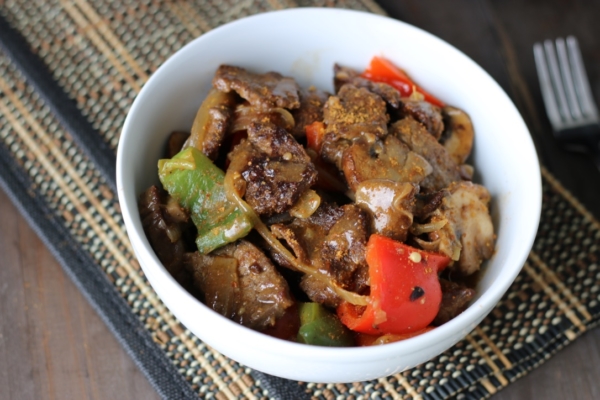
My dear suya spice, the king of my beating spice heart. I know you are not a novice to this blog so you know very well how much I love my suya spice, it’s really the ultimate blend for Nigerian cooking. So imagine my shock when I tried suya a joint on my last trip home and noticed they added curry powder to the mix, boy was I disappointed. I will like to hereby use this medium to appease to the gods of unnecessary innovations, you know the ones adding curry to suya, sugar to kulikuli etc. Mbok please leave the traditional recipes alone, innovation is great but not when it actually takes away goodness.
Sorry for my little rant, after all you are here for a recipe. Suya steak sauce, doesn’t it just sound delicious.
This recipe is delicious and versatile. Serve it with rice, bulgur or stir-fry with boiled pasta.
Ingredients
Steak
- 1kg Sirloin or flank steak (I am using flank) – Thinly sliced
- 1/3 cup soy sauce or salt to taste
- 1/3 cup water
- 2 Tbsp vinegar
- 1 Tbsp corn starch or flour
- 1 Tbsp suya spice
- 2 maggi cubes
Other
- 1 tbspn Suya spice
- 1 tbspn corn starch or flour
- 4 Tbsp oil (coconut or vegetable)
- 3 multi-color bell peppers – thinly sliced
- 1 large white onion bulb – Thinly sliced
- Thumb size ginger – minced
- 2 garlic cloves – minced
Direction:
- Combine 1 tbsp cornstarch, 1 tbsp suya spice and 2 cups of water. Mix thoroughly. .
- Combine all steak ingredients. Toss to combine. Set aside to marinate for 2 hours or overnight.
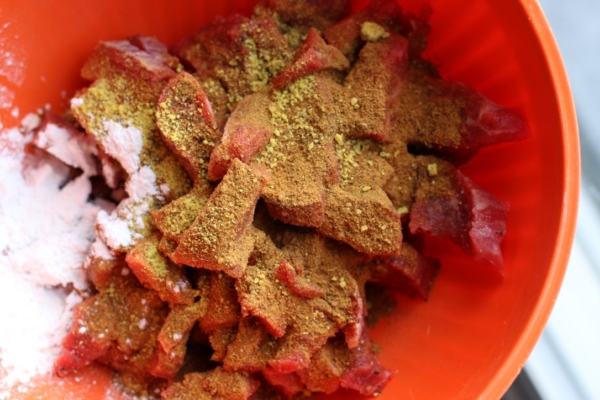
- Place a skillet on high heat. Heat up oil. Add in marinated steak and sear on all sides until brown (3-4 mins). Remove meat pieces and set aside.

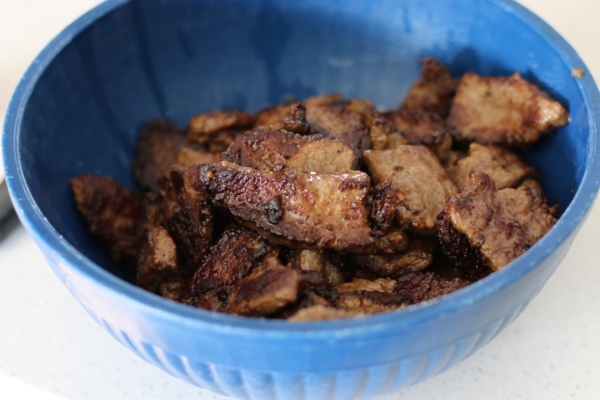
- Note if using smaller pan – do this in batches to prevent the steak from boiling instead of frying
- Add onions and vegetables into the hot pan (add more oil if needed). Stirfry for 2-3 minutes.
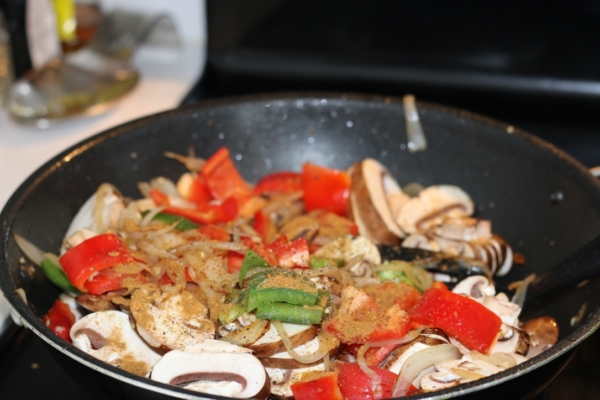
- Return the meat pieces to the pan. Add in suya sauce from step 2. Allow to simmer for another 2 minutes. Taste and adjust for seasoning.
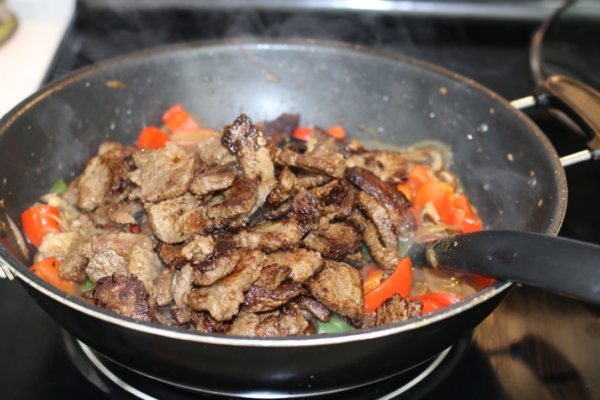
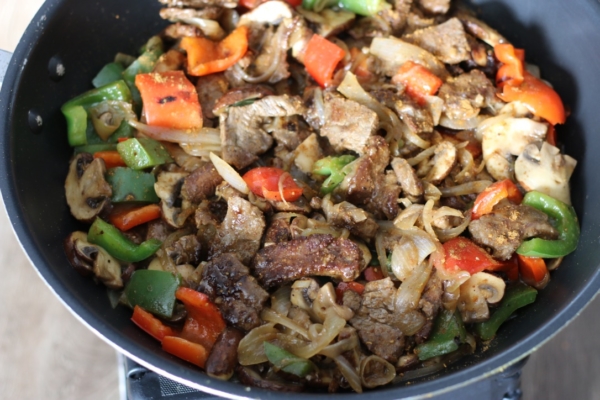
Serve over rice or bulgur.
Breakfast Yam Casserole

Yam and Egg Casserole
Here is a great idea for your next brunch, a fancy looking yam dish that is sure to please your guests. It’s a new twist on a beloved classic recipe, yam and eggs. This is somewhat similar to the to-go breakfast Yam cup recipe we created a while back but it’s in a class of its own. Think omelet with a well seasoned yam shell.Do take pictures and share with us when you try the recipe. The social media folks have dubbed this recipe Yamzza, a cheeky combination of Yam and pizza.
Ingredients
- 1/2 Medium Yam Tuber (700g) – Peeled and washed
- 1/4 cup Vegetable oil
- 7 Large eggs
- Salt, pepper and other seasonings to taste
- Handful chopped onion
- 1/2 Cup chopped Mushrooms
- 2-3 Cooked Sausage – Sliced
- 1/4 – 1/2 cup Shredded Cheese (optional)
- Handful Chopped tomato and green onions – to garnish
Direction :
- Preheat oven to 350F
- Using a hand held grater or food processor. Grate the raw yam. squeeze out as much moisture as possible from the yams and season with some salt and pepper

- Place a large non stick pan on medium heat. heat the vegetable oil. Add in seasoned yam, spread out and pack down with a spoon. cook until a crust forms underneath (3-5 minutes)
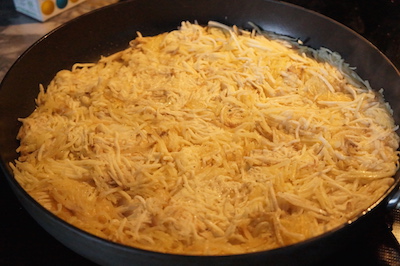
- In a large bowl, whisk together eggs,onion, mushroom, seasoning and half of the shredded cheese
- Pour egg mixture over yam to coat evenly. Top with sausage and leftover cheese. Cover loosely with aluminum foil and place in heated oven for 25-30 minutes. It’s cooked through when a toothpick insert comes out clean. Remove from oven
- Garnis
 h with tomatoes and green onions to serve
h with tomatoes and green onions to serve
- Enjoy!
- If you do not have an oven, you can make this recipe on stove top. Cover the pan loosely and cook on low heat for 25-30 minutes or until the egg is set.
- Yam may be substituted with sweet potatoes or Irish potatoes
- Bacon may be added into the recipe if you like
- Sausage may be substituted with Corned Beef
The Perfect Nigerian Fried Rice
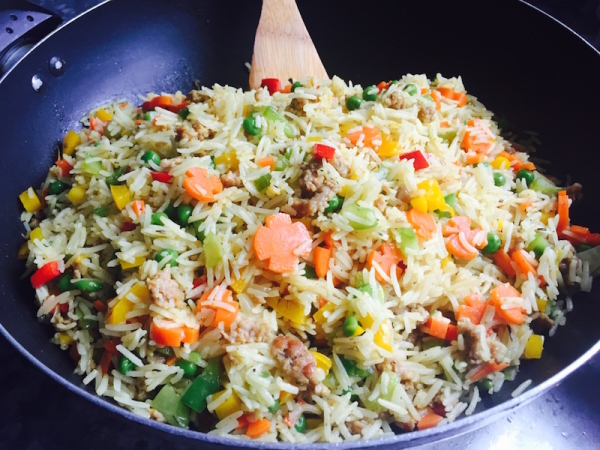
Nigerian Fried Rice
You are probably like 9jafoodie really? perfect? perfect is a strong word fah?! yes perfect! if there is one thing I can cook with both my eyes closed and one hand tied to the back, it is Nigerian Fried rice. I wasn’t really that obsessive about it until I started dating my husband.
You see hen, he is not the type to complain about anything, like NEVER. So you can imagine my surprise when he casually mentioned how much he detested improperly prepared fried rice, like to the point where he would rather starve. Ha! me I was just like ho really?… but in my head hen, I started thinking about the many ways to tighten my fried rice game. lol.
With the numerous techniques I picked up from our Asian cousins (who are the masters at fried rice between), I have my fried rice down to a science. You can go through feedback from people who have tried my coconut fried rice & basmati fried rice recipe. There are basic dos and don’t s for a perfect fried rice in my book, here they are:
1) Do season your boiled rice base or use broth; water doesn’t work
2) Don’t overcook your rice. This is the first step to a disastrous fried rice. If the rice is overcooked and mushy, please just remake it
3) Day old rice works best but it’s not a must. If you have a particular day you almost always make fried rice, make your parboiled rice a day before and store in the fridge
4) Season your vegetables while they are chopped and resting, it helps the overall flavour of the prepared rice
5) It’s okay to like your rice a little on the yellow/green side, however you don’t want an overpowering curry taste. Use turmeric for color and curry for flavor
Follow these suggestions and you will always prepare great fried rice.
Important Note:
The rice you use for the fried rice is just as important as the cook. I have been known to splurge a little on my rice. I have a trusted brand and I stick to it no matter the cost. Here is a handy water to rice ratio tip:
- basmati rice: 1 part rice to 1 1/4 parts liquid
- parboiled rice : 1 part rice to 2 parts liquid
The Perfect Nigerian Fried Rice
Prep time:
Cook time: 35 mins
Total time:
Serves: 6
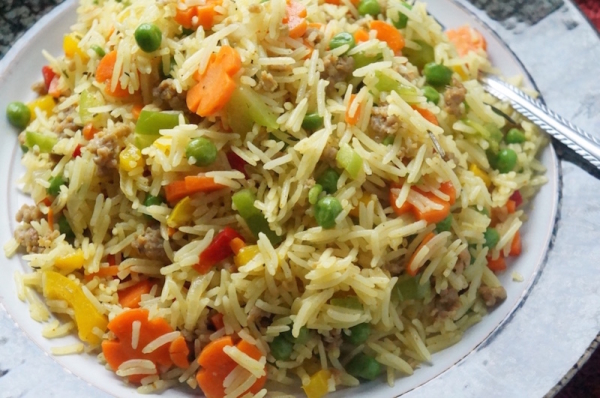
You may add protein into your fried rice. Shrimp, mincedmeat and chicken are great options. Thoroughly cook the meat and combine with prepared vegetables before adding in the rice.
Ingredients
Spices
- 2 bay leaves
- 2 sprigs fresh rosemary (optional)
- 2 cubes maggi
- 1 teaspoon salt
- 1 teaspoon white pepper (substitute other ground pepper)
- 2 teaspoon curry powder (divided)
- 1 teaspoon thyme
Other
- 4 tablespoons vegetable oil (divided)
- ½ cup chopped onion
- 3 cups mixed vegetables (bell pepper,carrot, peas, cabbage & sweetcorn)
- 2 cups rice (washed) (Parboiled or Basmati - please see note in introduction)
Directions
- Season chopped vegetables with some salt, maggi and pepper. Set aside
-I love to make my carrot into flower. Simply carve 4 thin incisions lengthwise on the carrot then slice. see photo below
- Place a large pot (with a good fitting lid) on medium heat. Heat up one part of oil and add in onion rosemary and bay leaves. Stir-fry until onion is fragrant and translucent. Add in 1 part each of curry, thyme, 1 cube maggi and 1 teaspoon of salt. Stir.Add in 4 cups water (3 cups if using basmati rice). Cover the pot, increase heat to high and bring the mixture to a boil.
Reduce the heat on the broth to low-medium add in the rice and stir. Cover the pot tightly. leave the rice to cook for 25 minutes (or 15 minutes if using basmati rice). Uncover the pot and spread the rice on a flat plate to cool
-if the rice isn't cooked to your liking, leave the pot covered for another 5-10 minutes (do not add more water)
-If the rice is cooked but there is still residual water in the pan,
leave the rice UNCOVERED on medium heat for another 5 minutes
leave the rice UNCOVERED on medium heat for another 5 minutes
- Place another large pot on medium heat, add in the left over oil and heat slightly. Add mixed vegetables and left over seasoning. Stir fry for 2-3 minutes
- Your rice is ready to serve. Enjoy with some fried plantain and stewed
- Combine the precooked rice and vegetables. Stir well to
- combine.
Pineapple fried ricePrep time:Cook time:Total time:Serves: 6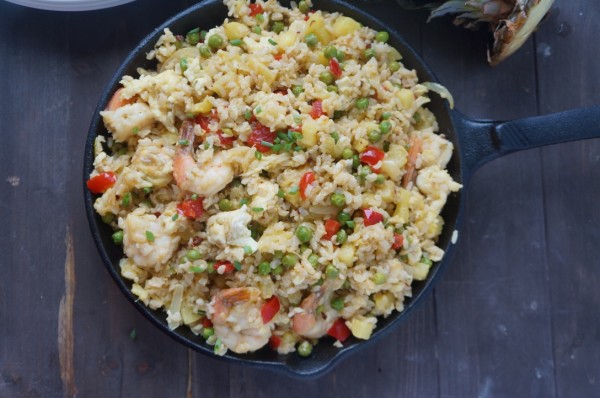 Ingredients
Ingredients- 3 Tablespoons coconut oil
- 1 small onion (chopped)
- 2 garlic cloves (minced)
- Thumb size ginger (minced)
- 4 raw eggs (cracked and beaten)
- 1 red bell pepper (tatashe) – chopped
- 1 -2 cups green peas
- 1 small pineapple (peeled and cubed)
- 2-3 maggi cube
- Salt – to taste
- 2 teaspoons white pepper
- 4 cups day old cooked rice (I used brown rice) (yeld from 11/4 cups raw rice)
- 16-20 shrimps (cleaned and seasoned with salt and pepper)
- Heat a large pan or wok on medium-high heat. Add in oil. Add in minced onion, garlic and ginger. Stirfry until onion is translucent and
- fragrant.
- Move the onions aside, add in beaten eggs and scramble. Remove the scrambled eggs and set aside
- Add in salt, maggi white pepper into the fried onions. Stir. Add in pineapples, peas, shrimp and red pepper. Increase heat to high and stir fry until most of the moisture is evaporated.
- Add in rice. Stir fry for another 3 minutes. Add in scrambled egg and gently combine.
- Fried rice is ready to serve. Serve with some spicy chicken








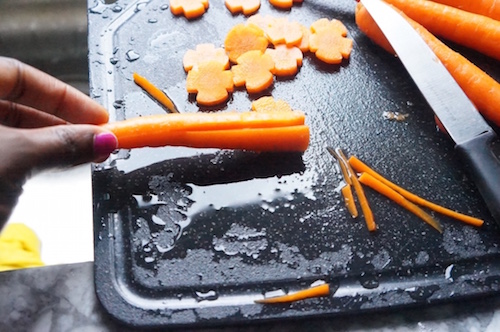
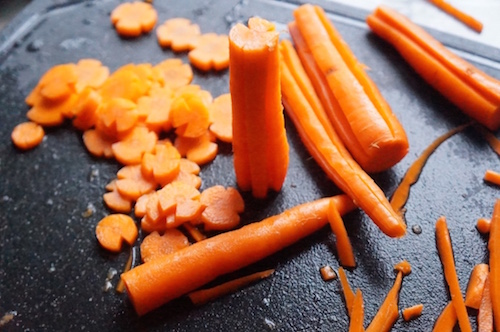
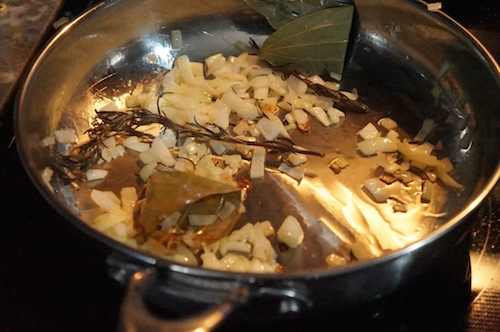
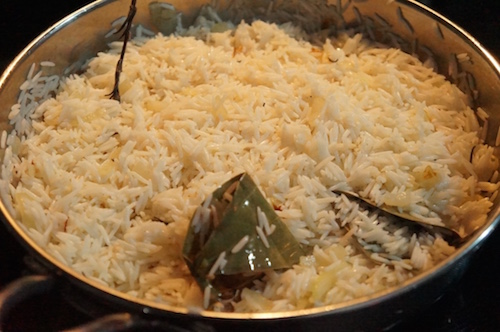
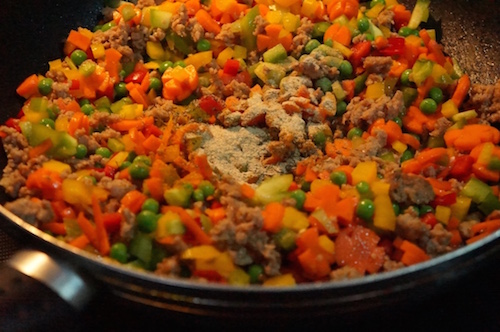
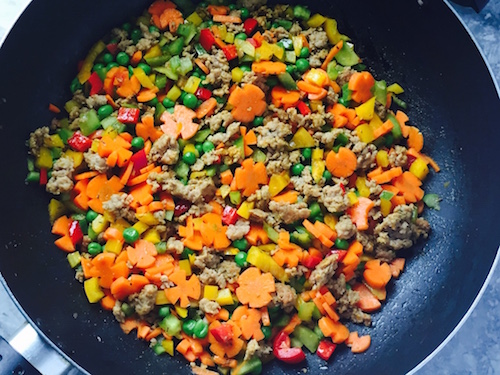
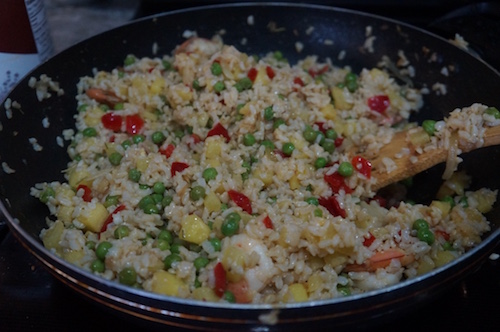
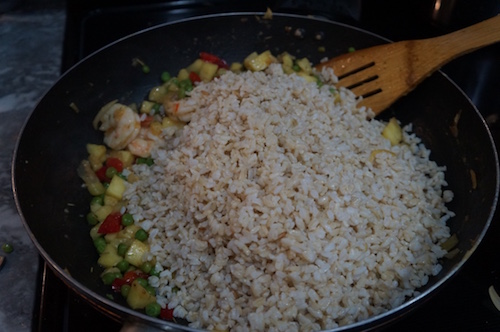
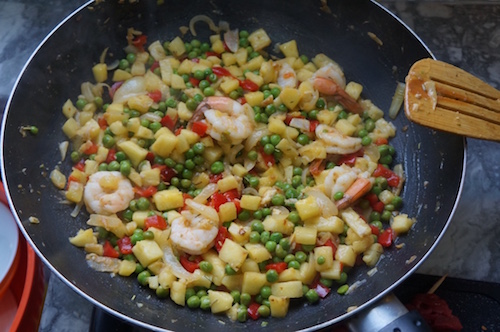
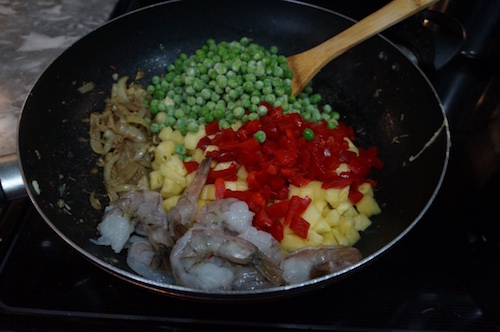
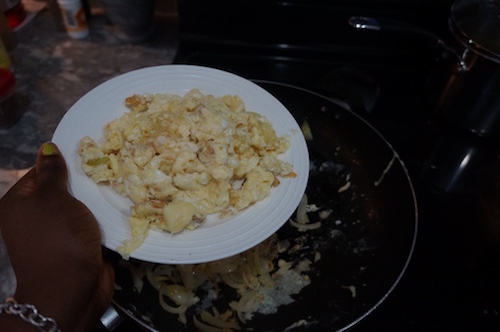
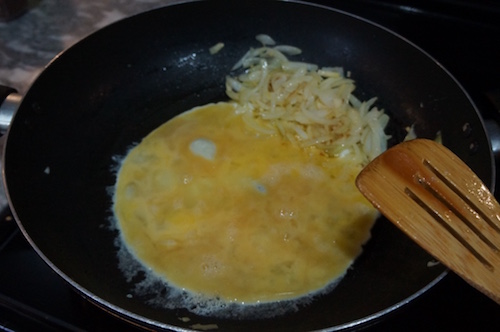
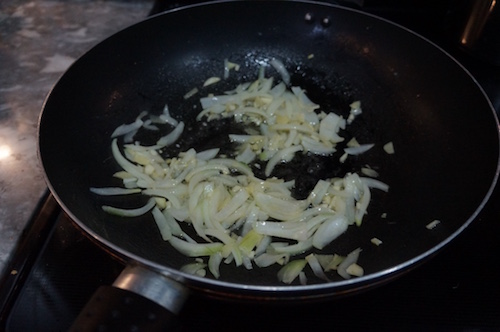
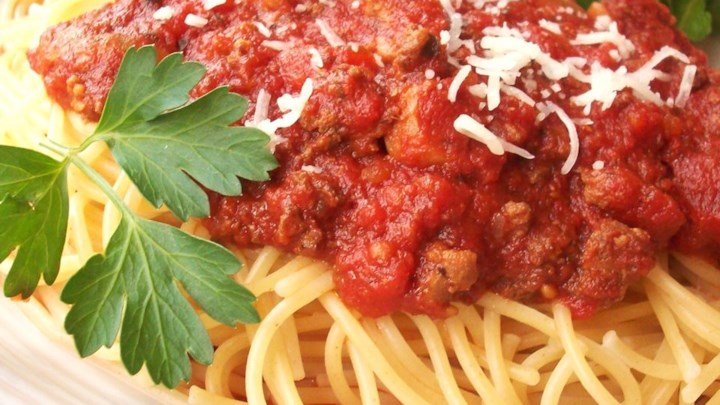
This is very nice i love it.It look like nigerian food recipes.
ReplyDeleteI just want to thank you for sharing your information and your site or blog this is simple but nice Information I’ve ever seen i like it i learn something today. Best Nigerian Restaurant London UK
ReplyDelete6 Best Protein Food You Need
ReplyDeleteBenefits of Fruits and Vegetables
Vitamin D: 9 Benefits and What you should know